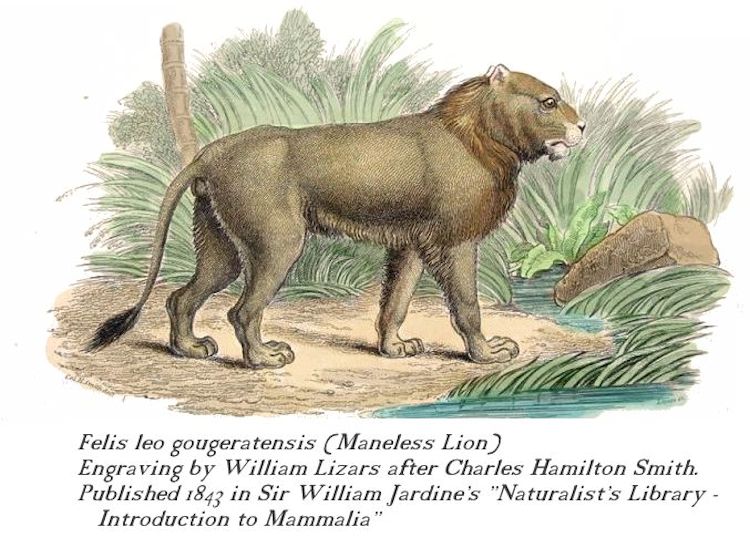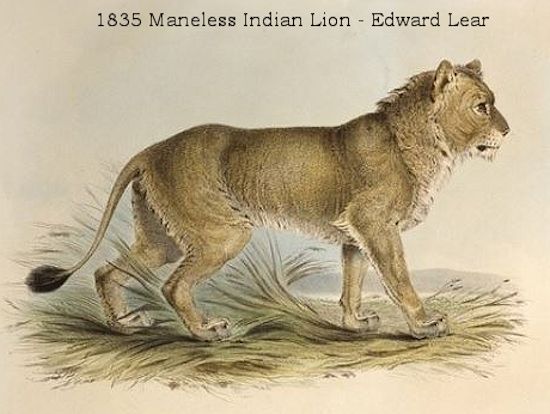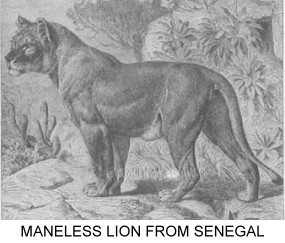
|
MUTANT BIG CATS - MANELESS LIONS |
Mutants are natural variations which occur due to spontaneous genetic changes or the expression of recessive (hidden) genes. In the past, the obvious reaction to any unusual big cat was to shoot it for the trophy room. As a result, many interesting mutations may have been wiped out before the genes were passed on. Some colour mutations which would disadvantage a wild big cat are bred in captivity and are not viable in the wild. It is questionable whether these mutants should be perpetuated for the sake of curiosity or aesthetics alone.
MANELESS LIONS

Proceedings of the Zoological Society, 1833:- The skins were exhibited of a Lion and Lioness killed in Guzerat by Captain Walter Smee, who, at tlie request of the Chairman, stated that they were selected from among eleven obtained by him in the same country, eight of which he had brought with him to England. The Lion is distinguished from those previously known by the absence of a mane from the sides of the neck and shoulders, the middle line of the back of the neck being alone furnished with longer hairs, which are erect like those in the same situation in the Cheetah, Felis jubata, Schreb. The under surface of the neck has long, loose, silky hairs, and there is a tuft at the angle of the anterior legs.
Captain Smee remarked that the existence in Guzerat of a maneless Lion had been known thirty years since by Colonel Sykes, and that Olivier had seen at Bagdad a similar animal, which was understood to have been brought thither from Arabia; but that hitherto, he believed, no skin of such a race had fallen under the observation of naturalists in Europe. Besides the absence of the extensive mane, it has to distinguish it from the ordinary Lion, a somewhat shorter tail, furnished at its tip with a much larger brush. Regarding it as a strongly marked variety of the Lion hitherto known, Captain Smee proposed for it the foliowing characters : Felis Leo, Linn., Var. Goojratensis. Juba maris cervicali brevi, erecta ; caudae flocco apicali maximo nigro. Habitat in Guzerat (et in Arabia?).
A male measured, including the tail, 8 feet 9 and-a-half inches in length. His total weight, exclusive of the entrails, was 4and-a-half cwt. The maneless Lion extends in Guzerat through a range of country about forty miles in length, where it is known as the Ontiah Baug or Camel Tiger, a name derived from its colour. In the hot months it is found in the low bushy wooded plains that skirt the Sombermutty and Bhardar rivers, from Ahmedabad to the borders of Cutch. It is destructive to cattle, but does not appear to attack man. When struck by a ball it exhibits great boldness, standing as if preparing to resist its pursuer, and then going off slowly, and in a very sullen manner; unlike the Tiger, which, on such occasions, retreats springing and snarling.
Captain Smee entered into various details respecting the animals exhibited by him, comprehending the heads of a paper "On the maneless Lion of Guzerat," which he had prepared for the Society.


Some lions, such as the Senegal lion show here are maneless or nearly so. This seems to be related to low testosterone production (which is why castrated lions are also maneless). The male of the original three white lions of Timbavati was also maneless. Manelessness is also found in inbred lion populations.
The less luxuriant mane of the Asiatic lion has also led to it being called the "Maneless Lion". According to the "Illustrated Natural History (Mammalia)" by Rev JG Wood, published in 1853 (my edition is the single volume Routledge 1874 edition):
As far as is known, the Lion which inhabits Asia is very similar in habits to that which is found in Africa, and therefore needs no detailed description. There is, however, one species, or variety, which ought to be noticed, on account of the peculiarity from which it derives its name. This is the “MANELESS LION” of Guzerat, so called from the very meagre mane with which its neck and throat are decorated. When first this animal was brought before the notice of naturalists, it was supposed to be merely a young male, whose mane had not yet reached its full development. It is now, however, allowed to be either a distinct species, or, at all events, a permanent variety, - between which opinions there is such very trifling difference that one is nearly is decided as the other. […] the mane is not altogether absent, as the popular name might give cause to suppose, but is very trifling in comparison with the luxuriant mass of hair which droops over the shoulders of the African Lion. The limbs do not appear to he quite so long in proportion as those of the last-named animal, and the tail is shorter, with a more conspicuous tuft. This tuft, by the way, is the readiest point of distinction which separates the Lion from the other cats. The natives term this animal the “Camel-tiger,” because its uniform tawny fur bears some resemblance in tint to that of the camel.
GENDER-CHANGING LIONS
A circus lioness exhibited by Terrell Jacobs allegedly became a lion. Sheba was a widely photographed lioness used in publicity photos with many famous names. She became even more photographed further when she developed a mane, allegedly evolved other male parts and became, to all intents and purposes, a male. This can occur for a variety of reasons. Although animals do not have a menopause in the same way as humans, elderly captive females may stop producing the female sex hormones. Because there is a low level of testosterone present naturally, this could trigger the growth of male traits such as a mane. For male sex organs to develop, the cat must have been a male whose development was incomplete or interrupted. Superficially resembling a female, an affected animal might eventually develop the traits associated with its genetic gender.A 15 year old white lioness named Vinkel became, to all intents and purposes, menopausal (hormonally imbalanced) and developed a mane.
Textual content is licensed under the GFDL.
For more information on the genetics of colour and pattern:
Robinson's Genetics for Cat Breeders & Veterinarians 4th Ed (the current version)
Genetics for Cat Breeders, 3rd Ed by Roy Robinson (earlier version showing some of the historical misunderstandings)
Cat Genetics by A C Jude (1950s cat genetics text; demonstrates the early confusion that chinchilla was a form of albinism)
For more information on genetics, inheritance and gene pools see:
The Pros and Cons of Inbreeding
The Pros and Cons of Cloning
For more information on anomalous colour and pattern forms in big cats see
Karl Shuker's "Mystery Cats of the World" (Robert Hale: London, 1989 - some of the genetics content is outdated)
|
BACK TO HYBRID & MUTANT BIG CATS INDEX |